When my husband Jason and I planned a trip to Vancouver, BC, we decided to bring our family’s bikes just in case. With our eight-year-old son Orion in tow, I wasn’t sure we’d have the chance to ride unless we sought out an off-street trail. To my surprise, we were able to ride—and not just on trails we had to drive or take a bus to, but through the heart of downtown Vancouver on a mixture of greenways and separated cycle lanes.
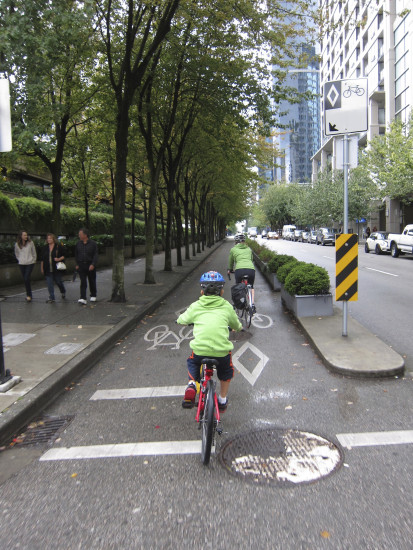
The last time we were able to ride in such an urban environment was when we lived in Copenhagen, Denmark. Then, Orion was nearly 2 years old. We bought a bike with a child seat in the rear and made our way through Copenhagen’s neighborhoods on a daily basis. The city’s network of traffic-calmed neighborhood roads, cycle tracks on main streets, and an off-street greenway network made bicycling with a small child comfortable and easy.
At that time, North American cities were taking a different approach. Bicycling advocates wanted to be treated as equal road users and argued that the safest place for them was to take their rightful place on the road in traffic. While I am all for equality, I definitely didn’t feel safe riding on roads in Seattle with or without my toddler. I kept to Seattle’s buses and sidewalks, not really seeing bicycling as an option for me or my young family.
Fast-forward to today, and Pacific Northwest cities are now embracing the “interested but concerned” bicycle demographic, residents like me who might ride but need better infrastructure. Prominent projects have shifted from sharrows to separated bicycle lanes, local bikeways, and neighborhood greenways. Transportation planners are developing street networks that serve people of “all ages and abilities,” where pedestrian and bicycle traffic is prioritized over cars.
A brief history of bike planning in Vancouver, BC
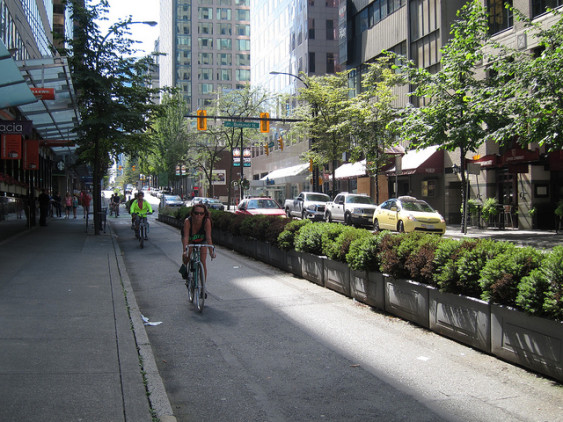
That’s exactly what is happening in Vancouver, BC. The city has long focused on creating a network of local street bikeways as well as an off-street bicycle path network starting with the Stanley Park Seawall. However, busier commercial streets and bridges lacked bicycle infrastructure. Some local street bikeways carried too many cars, making it uncomfortable for cyclists to share the road. Just adding bike lanes and sharrows to busier streets wasn’t helping attract as many riders as the city expected, so Vancouver opted for a new approach.
Kay Teschke, a University of British Columbia professor who has researched what types of bike facilities encourage people to ride, set up a survey of Metro Vancouver frequent, infrequent, and occasional cyclists. She found that all types of cyclists preferred off-street paths, traffic-calmed streets when sharing the road, and facilities that separate bikes from cars on busier streets. Teschke then studied what facilities are actually safest for cyclists and found they were largely the same.
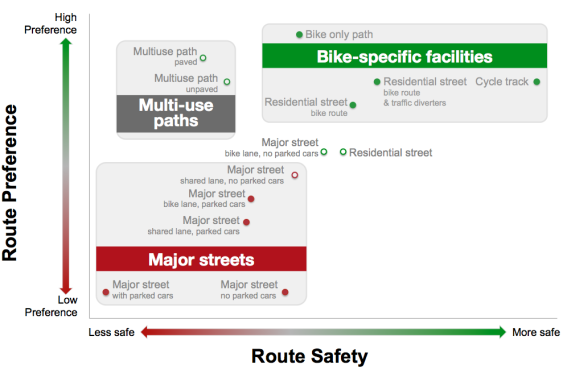
Through its Transportation 2040 Plan update, the city of Vancouver started reducing car traffic on bikeways, filling critical gaps in the cycle network, adding more greenways, and creating separated cycle lanes where motor vehicle volumes were too high to safely mix bikes and cars. The goal is to create a network of “neighborhood bikeways to get you much of the way from your home, then cycle tracks to get you to your destinations,” Kay Teschke explains. “The latter is new thinking both in bike advocacy and in the city planning groups, but it is definitely taking hold as the benefits of the few cycle tracks we have are becoming clear.”
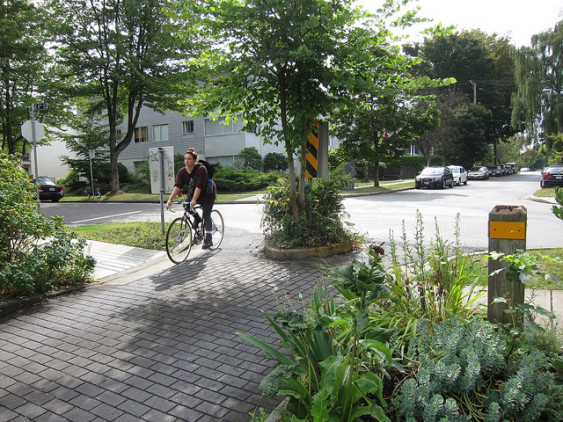
Those benefits include climbing ridership, more women bike commuters, more children riding with their parents, and more youth riding on their own, Teschke said. Between 2008 and 2011, for instance, bicycling was the fastest growing transportation mode in Vancouver, with 40% growth in the number of trips. Ridership by girls and women increased 93% between 2008 and 2011.
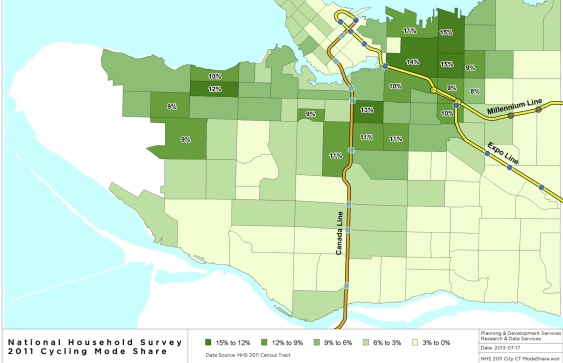
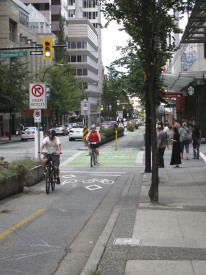
The changes have been particularly noticeable in places where the city added safer infrastructure. For example, the Dunsmuir neighborhood, which already had a high percentage of people who bike, saw a 40% increase in ridership between 2006 and 2011. That growth correlates with the installation of the Dunsmuir separated bicycle lanes. Overall, the number of Vancouverites riding bicycles to work increased from 3.7% in 2006 to 4.4% in 2011, compared to 6.3% in Portland and 3.45% in Seattle in 2011.
In the rest of this post, I’ll share some images from my family’s rides around Vancouver, BC, to show examples of the city’s local bikeways, greenways, and separated bicycle lanes.
Bikeways
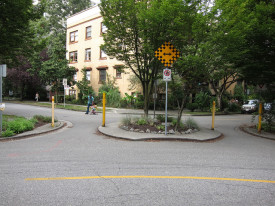
Local street bikeways are the cornerstone of Vancouver’s bicycle network. They’re supposed to be located on streets that don’t have a lot of cars to begin with, and where cars travel slowly enough that sharing the road feels comfortable and safe for cyclists. Bikeways have traffic calming features that prioritize bicyclists and pedestrians.
The city is currently focusing on making bikeways work as intended. When vehicle volumes are too high, a spot improvement program can add traffic calming features. When reducing numbers of cars isn’t possible, the city has taken portions of bikeway routes and added separated facilities for cyclists to get them out of car and truck traffic. For example, along Ontario Street, the bikeway has a bicycle-activated traffic signal where it crosses a busy street.
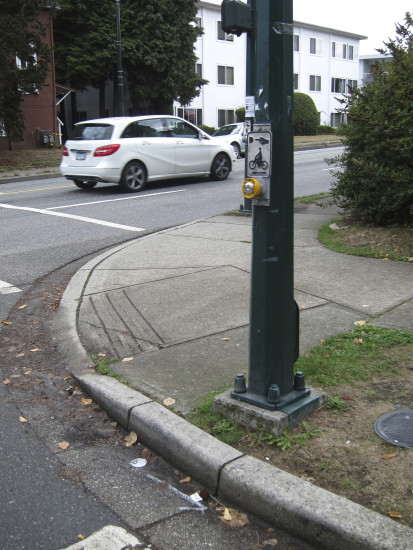
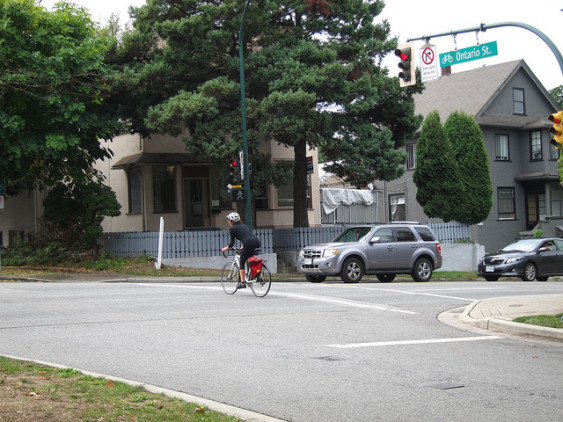
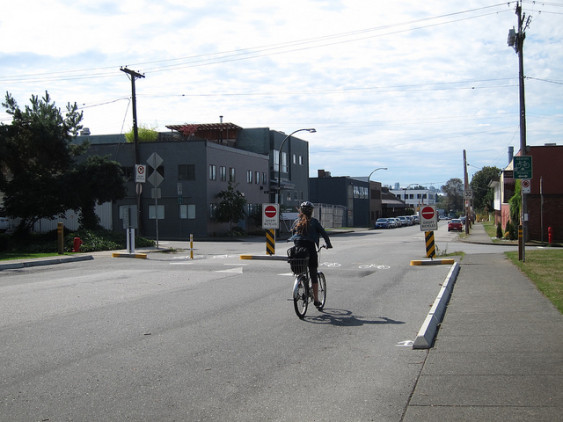
The Adanac Bikeway is a great example. It was the city’s first local street bikeway, and it carries large numbers of commuters into downtown from east Vancouver. While it follows pleasant neighborhood streets with few cars for most of its route, it merges with a busy freight route near downtown that carries about 5,000 vehicles a day. During the summer months, about 4,000 cyclists a day use the Union street section.
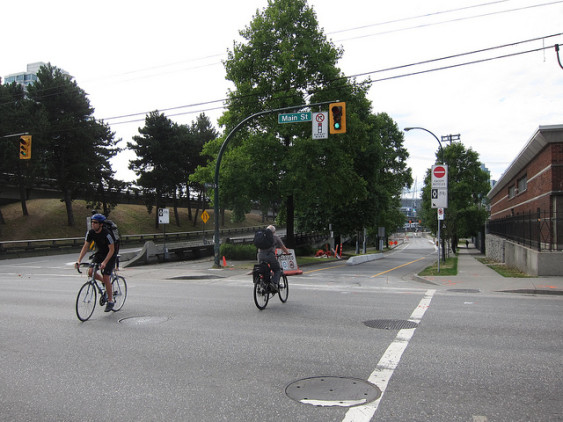
That helps explain why the intersection of Union and Main was a collision hotspot for the city, and why that stretch had the bikeway’s highest number of crashes between people driving and biking. To make the route safer, Vancouver closed Union west of Main to vehicles. In other spots, the city changed two-way streets to one-way streets and restricted vehicles from turning into bike traffic or crowds of people trying to cross adjacent streets.
Greenways
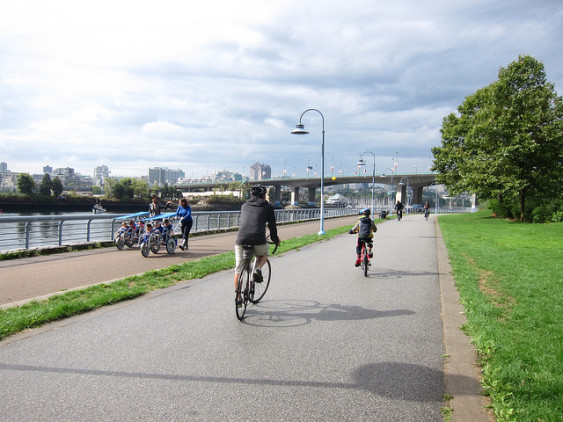
Greenways have a long history in Vancouver, BC. Actually, Portland—a city known for its greenway network—got the inspiration from Vancouver. In the early 1990s, Vancouver broadened the greenway concept beyond recreational pathways to include neighborhood residential streets and downtown streets. The Vancouver Greenways Plan approved by City Council in 1995 envisioned greenways crisscrossing the city in all directions and linking major parks, public facilities, and neighborhood hubs.
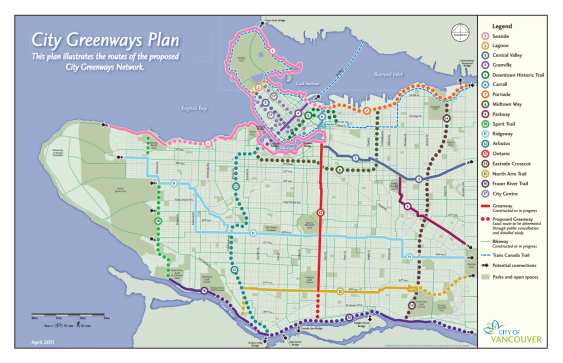
Vancouver sees greenways as a two-fer: They provide urban open space and give everyone from toddlers to ultra runners to retirees a comfortable transportation option. When complete, Vancouver’s greenway network will total about 85 miles and have 17 routes, with particular emphasis on dense, destination-rich areas like the downtown peninsula. But the goal is for every residence in the city to be within a 25-minute walk or a 10-minute bike ride from a greenway.
While the traffic-calmed bikeways strive to provide a safe and convenient cycling option, the city builds greenways to appeal to an even broader set of riders who may be less confident or riding purely for recreation. As city of Vancouver Sustainability Group Assistant Director Doug Smith explains:
Greenways are like linear parks on streets that are designed to encourage pedestrians and cyclists to commute to their destinations by not only providing infrastructure to make the route safe like traffic calming, adequate space, and safe crossings of busy arterials but also elements like trees, flowers, gardens, public art, fountains, and rest stops that encourage people to walk and bike just to enjoy the experience even if they don’t have a destination.
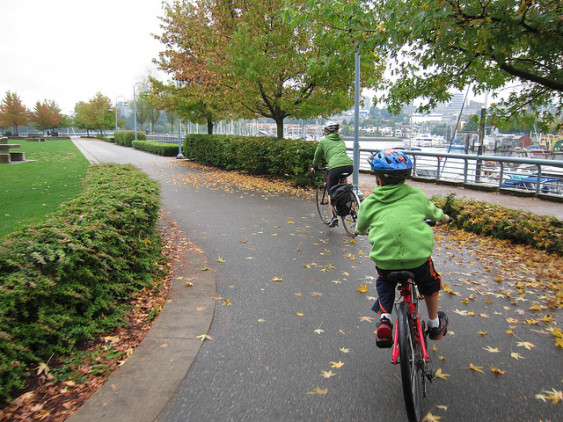
On our big ride to downtown, Orion, my husband Jason, and I took the Seaside Greenway from the Olympic Village neighborhood around False Creek to downtown.
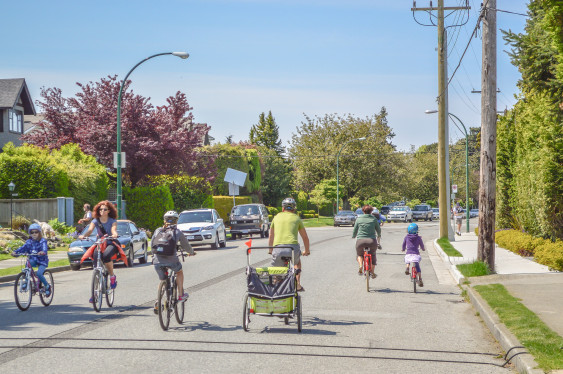
The Seaside Greenway is a well-loved open space that links Coal Harbor to Spanish Banks and runs along the seawall for much of its 17-mile route. Vancouver recently closed a critical gap in the greenway between the Burrard Street Bridge and Jericho Park with the Seaside Greenway Completion and York Bikeway project.
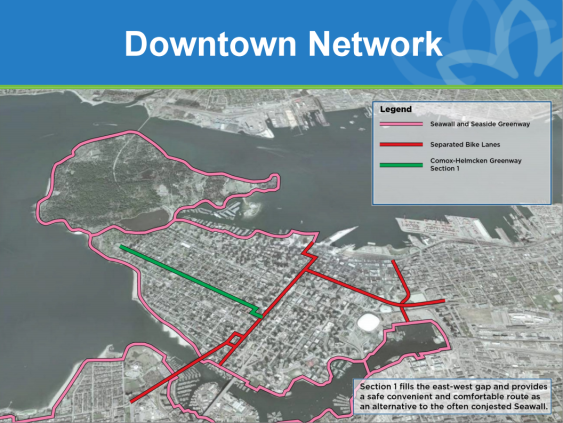
The city also installed an important east-west connection between False Creek and Stanley Park—-the first phase of Comox-Helmcken Greenway—in the summer of 2013. The city created a sequence of alternating one-way streets for vehicles, which reduced car volumes, made bicycling and walking more comfortable, and minimized the loss of on-street parking.
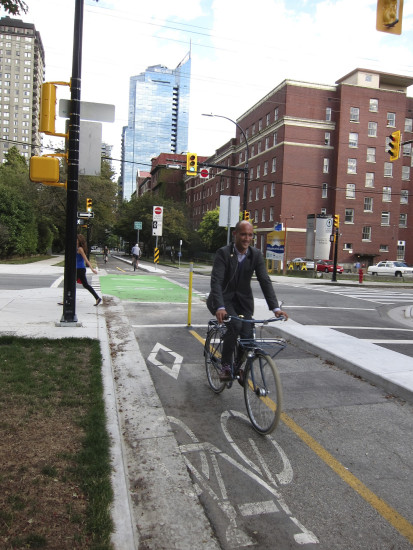
Because the routes have been designed to reduce vehicle volumes, cyclists share the road with vehicles most places along the greenway. However, on sections of the route that adjoin busier uses such as hotels, the greenway separates cyclists from cars.
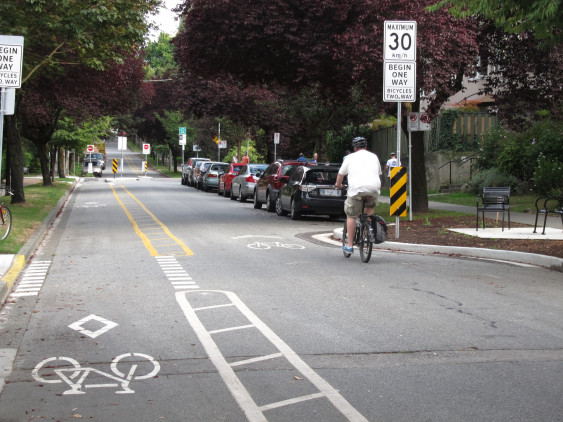
Where the road transitions to residential, the route has a painted lane for cyclists traveling against traffic while cyclists traveling the same direction share the road. There are also benches and greenery along the way to offer places to relax and socialize for people biking and walking.
Separated Cycle Lanes
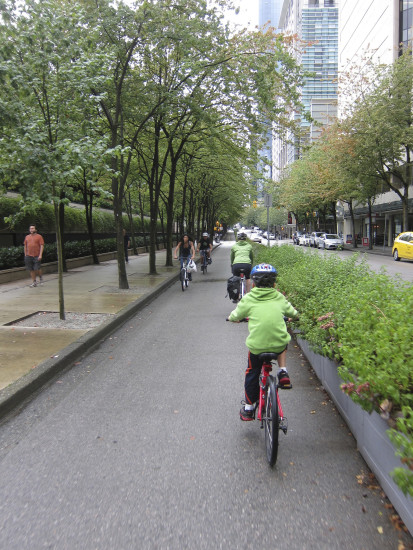
Continuing our journey to downtown Vancouver, we pedaled seamlessly from the Seaside Greenway to the separated cycle lane on Hornby Street. There, we found family-friendly infrastructure like physical barriers that separated us from moving traffic. At driveways, the lane was painted green to remind drivers to look out for bicyclists. Intersections had separate bicycle lights, and cars weren’t allowed to turn right when the light was green for bicycles. We cruised through downtown easily and safely, ending up at Robson Square in the heart of downtown.
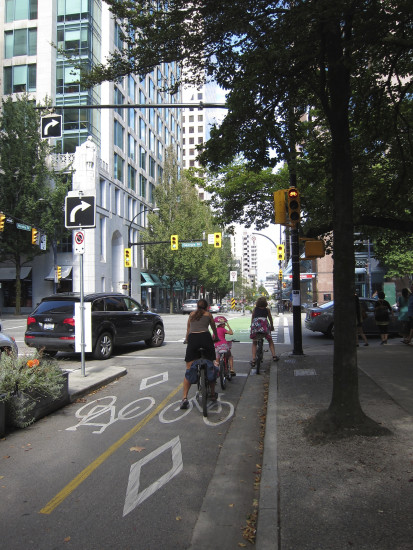
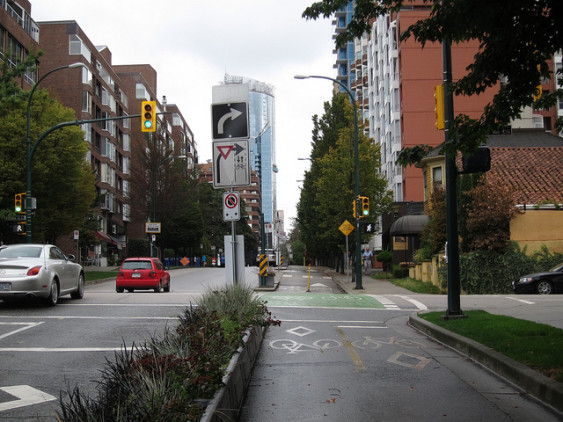
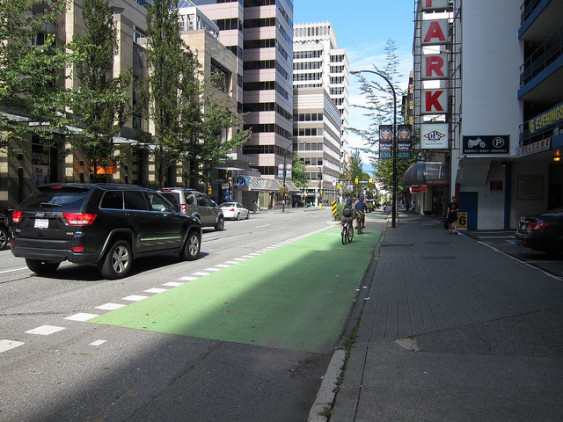
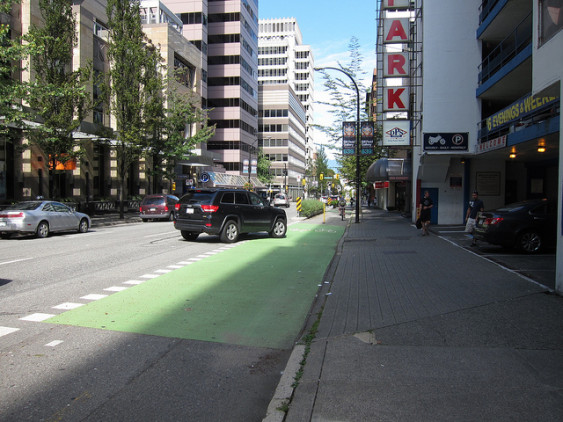
[sightline-embed]
Vancouver initially transformed a vehicle lane into a separated cycle path on the Burrard Bridge in 2009. The City then established three more downtown separated cycle lanes in 2010 on Dunsmuir Viaduct, Dunsmuir Street, and Hornby Street. Active Transportation Manager Dale Bracewell explains why in this Association of Pedestrian and Bicycle Professionals interview:
The prime impetus for this project was our desire to attract people of all ages and abilities to cycle, and to encourage the interested but concerned residents to feel safer and more comfortable riding a bicycle downtown. Though Vancouver has one of the highest bicycling rates in North America, very low collision numbers, and an excellent network of painted bicycle lanes and traffic calmed bikeways, many people were still not riding.
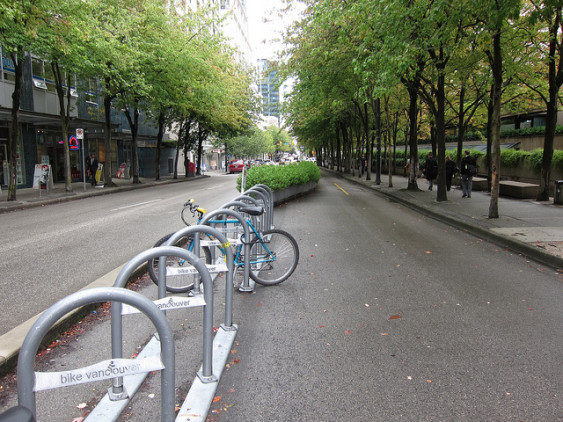
The summer of 2014 saw record numbers of cyclists on the separated lanes. Hornby Street’s separated bike lane, the one my family road during our ride, carried 71,000 riders in July 2014, surpassing its previous record high of 68,000 riders in 2011.
People biking aren’t the only ones enjoying the new separated paths. People walking also benefit from the added landscaping and buffer area from vehicles. According to Bracewell, there has been a dramatic reduction in cyclists riding on the sidewalk—an 80 percent reduction on the Horny separated route, which keeps the sidewalks open for people to walk.
In addition to attracting more riders and a more diverse cyclist base, the routes feel safer and actually are safer than before. There was a 20 percent reduction in all collisions—vehicle, cyclists, and pedestrians—on Hornby and Dunsmuir Streets after the separated bike lanes were installed.
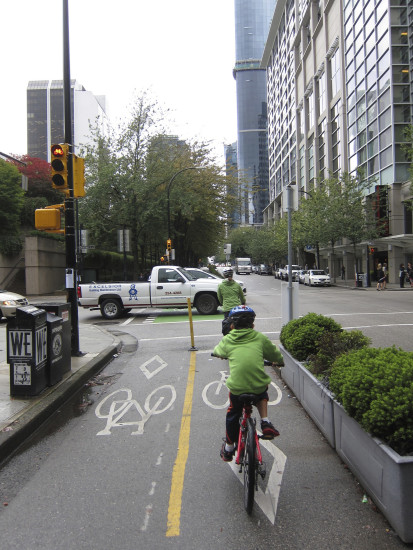
For my family’s ride, I was able to relax and enjoy the experience of riding through a big city’s downtown when we were on the Hornby separated cycle lane. Instead of frantically yelling commands to Orion, I was able to calmly ride and not worry about what the cars were doing. Conflict points at intersections and driveways were well designed, and the physical barriers between moving cars and the bike lane made the route much more comfortable.
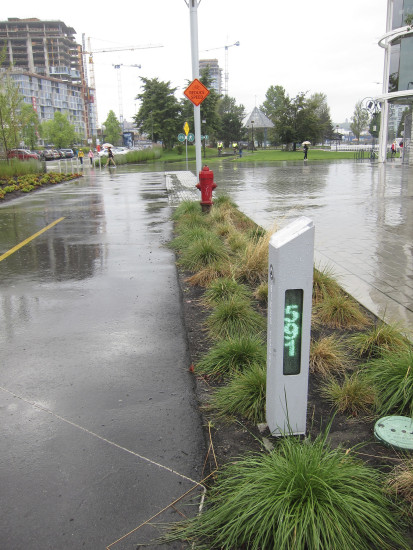
As we made our return trip back to False Creek later that day, we rode past a bicycle counter on the Seaside Greenway. My son smiled and yelled excitedly that he was cyclist number 591 to ride past the counter that day. I smiled, too—thankful that the City had planned such great bicycle infrastructure that made it possible for a family to ride safely, comfortably, and calmly in a major city.


Comments are closed.